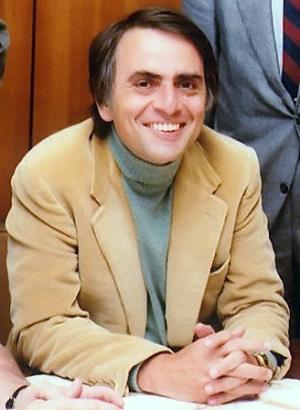Year born: 1934
Research Areas: Extraterrestrial Life, Planetary Science
"Not explaining science seems to me perverse.
When you're in love, you want to tell the world."
Source: Sagan, C. (1994) With ‘Science on our Side’ Washington Post, 9 January

Early Life
Carl Sagan grew up in Brooklyn, USA in a working-class family. Carl’s interest in astronomy began as a 5-year old child when he would visit the library to find books about stars. He loved science fiction books and became fascinated by extra-terrestrial life. As a teenager, he visited museums and science fairs, to learn as much as he could. He went to university aged 16, to study physics, alongside genetics, chemistry, and biology. He went on to earn a master’s degree and a PhD in physics, specialising in 'the physical studies of planets'.
Career Highlights
In the 1960s, Carl worked at the Smithsonian Astrophysical Observatory. He studied the physical conditions of the planets Venus and Jupiter. He discovered Venus' greenhouse effect, which creates the extreme temperatures that make Venus the hottest planet in our Solar System. He is known for his research on extraterrestrial life and was a champion of SETI, the Search for Extra Terrestrial Intelligence.
Carl also worked on NASA's space programme. He briefed the Apollo astronauts before their flight to the Moon, and consulted on the locations of the landing sites for various planetary probes. He developed experiments that were carried into space on robotic spacecraft. In his lifetime, Carl published over 600 scientific papers. He spent most of his career at Cornell University, where he directed the laboratory for Planetary Studies.
Carl believed in communicating science for at least two reasons: to gain public support for science and to share the excitement with others. In 1980, Carl narrated and co-wrote the award-winning TV series Cosmos: A Personal Voyage, which has become the most widely watched series in the history of American television. Carl has written over 20 books, including one to accompany the Cosmos TV series. His science fiction book “Contact” was adapted into a film. Carl has worked on numerous films, including as a scientific consultant on the movie 2001: A Space Odyssey. He became, arguably, the most famous astronomer of his time.
Legacy
Carl had the idea to turn the Voyager spacecraft around and use it to take a picture of Earth from beyond the orbit of Neptune. Carl coined the phrase “pale blue dot” to describe how small the Earth looked compared to the vast cosmos. Voyager 1, which has travelled further than any other space craft, also carries a golden record that contains sounds and images to show any intelligent aliens what life on Earth is like. Carl chaired the committee that selected what went on the record.
